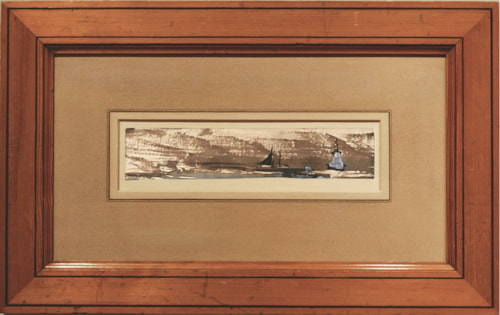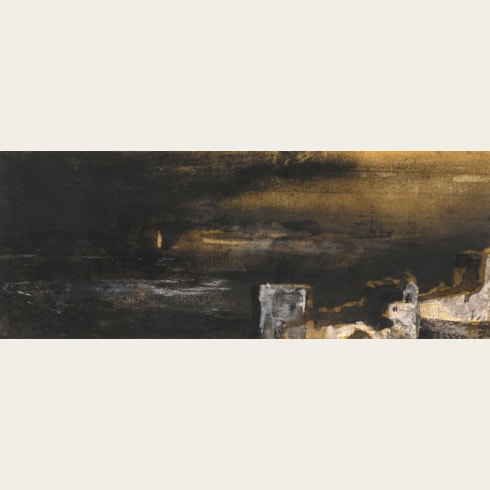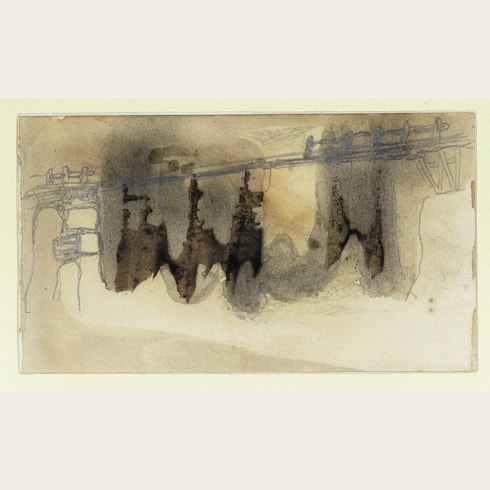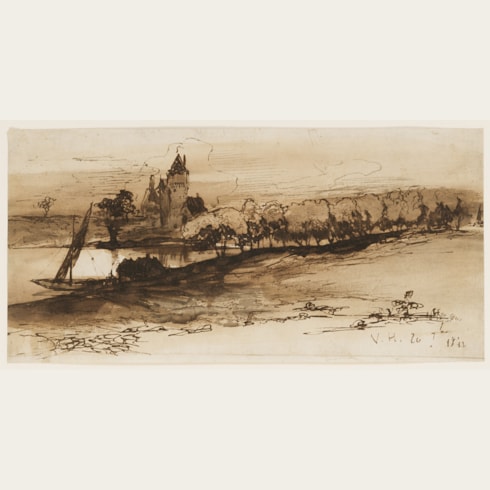Victor HUGO
(Besançon 1802 - Paris 1885)
Seascape with Ships in Fog
Pen, brush and brown ink and brown wash, with touches of white gouache.
56 x 247 mm. (2 1/4 x 9 3/4 in.)
56 x 247 mm. (2 1/4 x 9 3/4 in.)
The present sheet was drawn during Victor Hugo’s fifteen-year period of exile in Guernsey, when he came to be fascinated by the majestic vistas of sea and sky that he saw around him. As he wrote in 1859, in a letter to a friend, ‘I need these periods of rest sometimes in my solitude, in face of the ocean, amid this sombre scenery which has a supreme attraction for me and which draws me toward the dazzling apparitions of the infinite.’ The rugged coastline and rock formations of Guernsey provided Hugo with a variety of dramatic motifs for his drawings. He would spend a considerable amount of time wandering over the island, at all times of the day and night, and took a large number of photographs of the scenery, with the intention of publishing a book of them in collaboration with his son Charles.
Hugo’s favourite subject was always the sea. As Pierre Georgel has noted of the drawings made during his stay in the Channel Islands, ‘his visual world became enriched almost to the point of obsession with the spectacle of the sea. But this grandiose, monotonous horizon never changed. As a result, the graphic work moved further and further away from the real in an attempt to catch the kaleidoscope of sea, rock and cloud, or to reflect the ebb and flow of an imaginary world in which shapes could form and dissolve in an instant.’ Even after his return to Paris in 1870, Hugo continued to visit Guernsey, and to produce drawings inspired by its bold and dramatic landscape.
The first owner of this drawing was the playwright and novelist Paul Meurice (1818-1905), a lifelong friend of Victor Hugo. During the period of Hugo’s exile, Meurice looked after his financial and literary interests, and upon the writer’s death was named one of the executors of his estate. Meurice owned a large group of some of the most significant drawings by Hugo, and was responsible for organizing the first exhibition of them, in Paris in 1888. In 1902, he established the Maison de Victor Hugo in Paris, which, together with the Bibliothèque Nationale, today holds the largest collection of drawings by Hugo.
Hugo’s favourite subject was always the sea. As Pierre Georgel has noted of the drawings made during his stay in the Channel Islands, ‘his visual world became enriched almost to the point of obsession with the spectacle of the sea. But this grandiose, monotonous horizon never changed. As a result, the graphic work moved further and further away from the real in an attempt to catch the kaleidoscope of sea, rock and cloud, or to reflect the ebb and flow of an imaginary world in which shapes could form and dissolve in an instant.’ Even after his return to Paris in 1870, Hugo continued to visit Guernsey, and to produce drawings inspired by its bold and dramatic landscape.
The first owner of this drawing was the playwright and novelist Paul Meurice (1818-1905), a lifelong friend of Victor Hugo. During the period of Hugo’s exile, Meurice looked after his financial and literary interests, and upon the writer’s death was named one of the executors of his estate. Meurice owned a large group of some of the most significant drawings by Hugo, and was responsible for organizing the first exhibition of them, in Paris in 1888. In 1902, he established the Maison de Victor Hugo in Paris, which, together with the Bibliothèque Nationale, today holds the largest collection of drawings by Hugo.
The preeminent literary figure in 19th century France, Victor Hugo was also an accomplished and prolific draughtsman. He produced nearly three thousand drawings, the principal groups of which are today in the collections of the Bibliothèque Nationale and the Maison de Victor Hugo in Paris. He began to draw seriously around 1825, but relatively little of this early work survives and it was not until some twenty years later that he was to develop his distinctive personal idiom. Hugo seems to have been most productive as a draughtsman during periods when he was writing less, as for example in 1850. Conversely, there are very few drawings from the period between 1852 and 1853, when he was engaged on a spell of intense literary activity. His drawings achieved a height of expression during the years of his political exile from France on the Channel Islands of Jersey, where he and his family lived from 1852 to 1855, and Guernsey, where he settled in 1855 and remained until 1870. Although he often gave drawings as presents to friends and colleagues, and allowed several sheets to be reproduced as engravings, the act of drawing for Hugo remained a largely private occupation. In the last ten years of his life, he drew much less, a decline mirrored in his literary output.
As a draughtsman, Hugo relied primarily on brown or black ink and wash, applied with a fluidity and transparency that allowed for remarkable tonal and atmospheric effects. His idiosyncratic working methods have been described by his son Charles Hugo: ‘Once paper, pen and ink-well have been brought to the table, Victor Hugo sits down and without making a preliminary sketch, without any apparent preconception, sets about drawing with an extraordinarily sure hand not the landscape as a whole but any old detail. He will begin his forest with the branch of a tree, his town with a gable, his gable with a weather vane, and, little by little, the entire composition will emerge from the blank paper with the precision and clarity of a photographic negative subjected to the chemical preparation that brings out the picture. That done, the draftsman will ask for a cup and will finish off his landscape with a light shower of black coffee. The result is an unexpected and powerful drawing that is often strange, always personal, and recalls the etchings of Rembrandt and Piranesi.’
Hugo also experimented with different techniques and media, including inkblots (taches), folded paper, stencilled cut-outs, gold leaf and impressions taken from various objects, including leaves and lace.
Provenance
Paul Meurice, Paris
By descent to his adopted daughter, Mme. Marie Ozenne Meurice
Henri Guillemin, Paris and Neuchätel
Anonymous sale, Paris, Hôtel Drouot, 13 June 2001, lot 150
Jan Krugier and Marie-Anne Poniatowski, Geneva.
Literature
Jean Massin, ed., Victor Hugo: oeuvres complètes, Paris, 1967, Vol.I, no.876; Raphael Rosenberg and Max Hollein, ed., Turner Hugo Moreau: Entdeckung der Abstraktion, exhibition catalogue, Frankfurt, 2007-2008, no.100, illustrated p.174; Florian Rodari, ed., Victor Hugo: Dessins visionnaires, exhibition catalogue, Lausanne, 2008, no.26, illustrated p.41 (where dated c.1856); Felix Krämer, ed., Dark Romanticism: From Goya to Max Ernst, exhibition catalogue, Frankfurt, 2012-2013, no.62, illustrated p.121; Gerhard Kehlenbeck, Victor Hugo: Visions of a Poet-Draughtsman, Hamburg, 2015, unpaginated, no.4.
Exhibition
Frankfurt, Schirn Kunsthalle, Turner Hugo Moreau: Entdeckung der Abstraktion, 2007-2008, no.100; Lausanne, Fondation de l’Hermitage, Victor Hugo: Dessins visionnaires, 2008, no.26; Frankfurt, Städel Museum, Dark Romanticism: From Goya to Max Ernst, 2012-2013, no.62; Paris, Musée d’Orsay, L’ange du bizarre: Le romantisme noir de Goya à Max Ernst, 2013, no.45.








